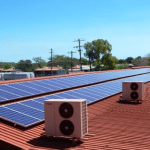The privately owned Australian generation company Alinta Energy is pushing for a change of rules in market operations that would force small renewable energy installations – small wind farms and even rooftop solar arrays – to act in the market in the same manner as large coal-fired generators.
In an apparent reaction to the growing threat of smaller, distributed generation facilities – and in particular the potential emergence of numerous aggregated fleets of really small generators (pooled rooftop solar, for instance) – Alinta is pushing for a change of rules that would require systems as small as 5MW to become “scheduled” generators in the National Electricity Market.
The impact of such a requirement would be to add costs and red tape to smaller generators that could make their operation less economic. Alinta argues that it is necessary to protect the interests of the incumbent utilities.
The proposals were made in a discussion paper presented to the Australian Market Operator, which is holding a holding a consultative meeting on the wholesale market today.
The Alinta submission is focused on details of NEM operations that would not normally warrant outside interest. But what is interesting and significant about its stance is the recognition of the growing trend towards distributed generation, and the growing impact it is having on incumbents, who are finding their output is not required as often in the past, or that they are getting less money for that output.
This is part of the quandary facing energy market operators around the world – how to incorporate the growing move to generation that is consumed on-site or nearby, and manage the efficiency of a large grid.
Alinta’s main assets in the NEM are its Northern and the mothballed Playford coal-fired generators in South Australia, which are some of the oldest and most inflexible in the market, with a poor ability to ramp up or down in response to changing demand and supply.
Alinta, which is preparing for a sale by its private equity owners, has previously called for the renewable energy target to be scaled back, and has also called for the market cap – currently at $12,000 – be extended to provide greater incentive for new peaking plant.
Alinta says installations such as its own coal generators are increasingly disadvantaged by the emergence of smaller generators. And while it says that the NEM requires a stable regulatory regime, it suggests changes to existing arrangement for “non scheduled generators” to remove what it describes as “market anomalies.”
“There is little doubt that embedded generation has an important and growing role to play in meeting the energy supply needs of consumers and industry in Australia,” it says in its submission.
“The question being posed is to what extent have changing patterns in investment in embedded generation begun to undermine market efficiency due to current arrangements. Further, is there potential for the concerns identified, to grow in the outgoing years.”
It wants to impose requirements that all generators above 5MW act as scheduled generation within the NEM – meaning that they have to provide the market operator with details about their availability and ability to respond to changing demand. It says this will help in forecasting and the efficient scheduling of production.
It events want this requirement to be imposed on “aggregated solar” – where companies aggregate the output of rooftop solar generators, and even on “self consumption” – where that output is consumed on site.
Such aggregated facilities have yet to appear on the market, but there is growing interest in putting together such deals, particularly as solar systems are getting a poor return from their output from electricity retailers. Some financiers suggest pooling facilities could unlock a new wave of development in commercial and distributed solar.
“The current arrangements provide too great an exemption and therefore the threshold for special treatment should be for units of 5MWs or less not 30MWs,” Alinta writes.
“Further, 5MW units should only be exempt where they are not part of a large aggregated portfolio within the same region. This takes account of the potential for sizeable fleets of mini-generators operating in aggregate.”








